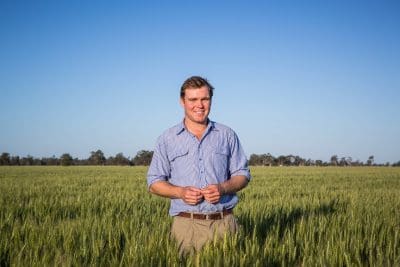GRAIN growers considering an investment in ‘on-farm storage’ options should establish clear goals, consider future needs and plan with potential expansion in mind so as to maximise value, according to a new Nuffield report released today by 2015 Scholar, Andrew Freeth.
Mr Freeth works on his family’s 5500-hectare dryland broadacre cropping and livestock enterprise at Collie near Gilgandra, New South Wales, and has spent the past two years studying effective on-farm grains storage and supply chain logistics, from around the world.
Funded by the Grains Research and Development Corporation (GRDC), Mr Freeth’s report has unveiled a suite of recommendations for moving grain to market in an efficient, cost-effective manner, whilst considering future trends affecting the industry.
As a passionate advocate for the grains industry, Mr Freeth said growers had seen unprecedented structural change over the past 25 years, including the need to increase storage capacity on-farm and improve sophistication of existing infrastructure.
“The competitiveness of Australian grain growers rely on an efficient supply chain into domestic and export markets,” he said.
“But in order to capitalise on these opportunities, growers are looking at newer, more innovative ways to reduce their supply chain costs and boost their profitability.
“One of these is investing in On Farm Storage (OFS), a growing trend being driven by harvest logistics and capacities, upcountry grain storage networks, increasing production of pulse and specialty crops, amongst a range of other industry and government incentives.”
OFS continues to gain momentum in the grains industry as growers look to expand their cropping enterprises, but Mr Freeth said there was no strict formula for the optimal mix of OFS options.
“It’s not a one size fits all approach,” he said. “Factors such as build quality, cost, ease of management and segmentation will play a key role in determining which OFS model works best for your business.
“Doing your homework and building a strategy which looks at how economically viable OFS is to your business, and aligning this with a broader marketing and management effort is absolutely critical.
“As some of these storage options can have working lives in excess of 30 years, it’s important to take a long-term view about how OFS may be affected by the micro and macro operating environment – and build that into your strategy accordingly.”
Once growers establish which OFS system they would like to proceed with, Mr Freeth suggests a robust pest management strategy, so as to reduce input costs and risks on farm.
“Simply building OFS and filling it with grain does not guarantee success,” he said.
“For instance, good hygiene and aeration is important when growers are storing grain in an unsealed environment, alternatively gas tight storage that meets standard, AS2628, is a must for growers fumigating grain storage pests.
“With the amount of Australian grain crops stored on farm likely to grow, it’s vital that best practice is followed, which means grain remains in good condition for long periods of time or when the time is right to on-sell.
“Through my Scholarship, I was able to see some of the advancements in grain storage on farms overseas, and if we can achieve those same gains here, there is no reason we can’t see OFS reach levels of up to 50 per cent market share, as seen in countries like the United States.”
More broadly, Mr Freeth said that government needs to provide the right policy settings to meet the needs of a modern grains industry, its consumers and the companies that operate within the supply chain.
“A modern and cost-effective freight network will be a game-changer for Australian agriculture,” he said.
“The Government’s announcement of the Inland Rail line funding has been welcome news for growers, with productivity gains expected across the rail and port operations of Australia’s east coast.
“It’s anticipated the Inland Rail will accelerate the rationalisation of the ‘upcountry’ storage network, so as to reduce transportation costs and improve profitability of supply chain operators.
“Further to this, new partnerships between grain growers, trading businesses and supply chain operators will be critical to ensure productivity improvements from mainline operations follow through to higher prices at farm-gate.”
…………………………………………….
Mr Freeth will be attending the Nuffield 2017 National Conference being held on 19 – 21 September in Darwin.
Source: Nuffield Australia, www.nuffield.com.au



HAVE YOUR SAY